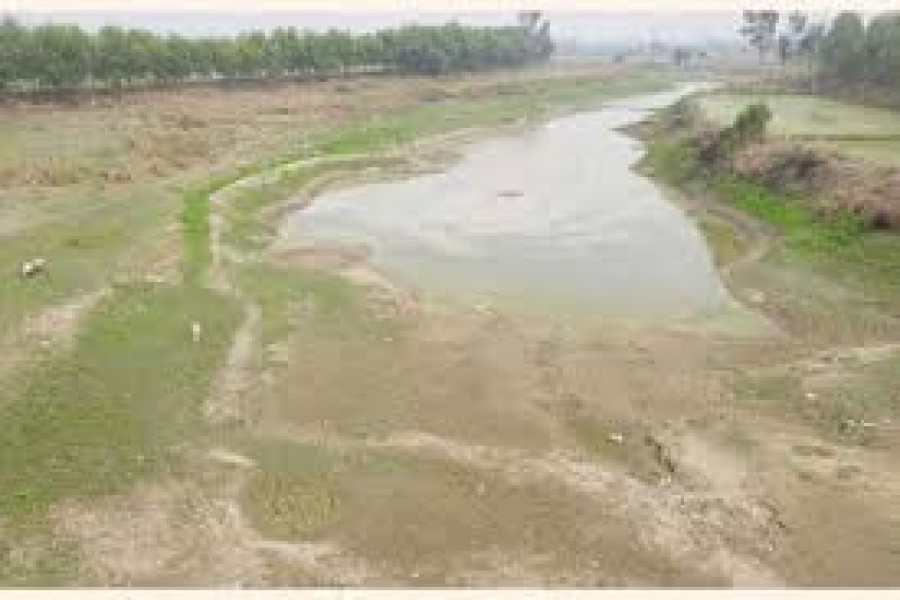It's an old story in a deltaic land, crisscrossed by innumerable rivers, called Bangladesh. Pledges are often made from different levels of the government for protecting the rivers - the lifeblood of the country's agriculture and environment. The courts occasionally issue directives for taking measures to save them. There are reports on various initiatives like excavation and dredging of rivers.
Nevertheless, the ones who occupy and pollute the rivers as well as river banks by banking on the blessings from powerful quarters remain unstoppable. The tasks of protecting the rivers therefore remain confined to mere pledges and slogans. The result is gradual shrinking and drying of numerous rivers.
As many as 158 of the country's rivers have dried up in the past 57 years, according to two recent surveys. In 2010, a team from Geography department of Jahangirnagar University released a report on depleting number of rivers in Bangladesh from 1963 to 2000. The report claimed that 115 rivers had dried up and were almost dead. The other survey, carried out by NGO 'Uttaran', claimed that 43 rivers had dried up during the 2000-January 2020 period alone, and this trend is unlikely to be reversed as construction of unplanned coastal embankments and infrastructures as well as river grabbing and encroachment continues unabated.
Just as the rivers are drying up due to fall in water flow, similarly pollution is having a devastating effect on their longevity. Despite sufficient flow of waters in many rivers, the extent of their pollution is so high that the river water can no longer be used for any purpose. The Buriganga, Balu, Shitalakshya and Dhaleswari occupy the top spots in this list. According to a review of 143 research surveys published in international journals over the period between 1991 and 2019, heavy metals that are highly damaging for human health have been found in 32 rivers. The highest proportion of poisonous metals was found in the river Buriganga, followed by Balu and Shitalakshya.
There are numerous agencies responsible for looking after the country's rivers and waterways. The Bangladesh Inland Water Transport Authority (BIWTA) supervises the water transportation sector; the Water Development Board (WDB) carries out the tasks of protecting river banks and undertaking excavations; the Ministry of Land grants leases of water bodies; the Department of Environment examines quality of river water; the Forest Department looks after conservation of flora and fauna in rivers; Bangladesh Agricultural Development Corporation (BADC) arranges irrigation through supply of river water and also undertakes construction of rubber dams; the Department of Public Health Engineering and the Water and Sewerage Authorities are entrusted with responsibility of collecting water from rivers and then supplying purified water to towns and cities.
Overall, the responsibility of conserving the country's rivers has been vested on the National River Conservation Commission (NRCC).
The NRCC published an updated list of 49,558 river grabbers in 2019. These offenders include influential industrial groups, institutions, individuals and politicians. But the commission has not yet been able to ascertain the actual number of rivers in Bangladesh. The last survey conducted by the WDB in 2010 (released in 2011) based on the satellite images of NASA as well as field-level data claimed the number of rivers to be 405. Before that, the WDB publication 'Bangladesher Nadnadi' (Rivers of Bangladesh) showed the number at 310. But the numbers vary between 700 and 800 in other government documents as well as the national encyclopaedia 'Banglapedia'.
However, the then minister for water resources, during question-answer session of parliament in 2012 claimed that the number was 310. Of them, 212 were in good shape, and 97 were in death-throes. And a river named 'Bhola' had completely disappeared from Bagerhat after independence.
About 80 per cent of Bangladesh territory has emerged from river sediments. The river networks are interlinked with each other. Therefore other rivers are affected when any river dries up or gets delinked. It is seen quite often while constructing infrastructure on river banks that the water flow and management of sediments are not taken into cognizance. Any properly drawn-up plans are not implemented. Many rivers have dried up due to stoppage of normal flow. Experts say at least 100 Bangladesh rivers have dried up since the 1960s.
In the above backdrop, a landmark verdict was delivered by the High Court Division of the Supreme Court on February 03, 2019, the full text of which was released on July 02, 2019. It termed river-grabbing as a criminal offence, and the killing of rivers as 'collective suicide'.
It granted the Turag river the status of a 'legal person' cum 'living entity', and issued a 17-point directive to the government. The directives included: the Election Commission should declare river encroachers and polluters ineligible for contesting any election; the Bangladesh Bank should issue a circular directing all banks not to give loans to river grabbers and polluters; the government must make a list of river grabbers and publish it; as the legal guardian for conservation of rivers, the National River Conservation Commission (NRCC) should act like their parents.
The High Court also asked the government to amend the NRCC law in order to empower it for more effective performance, and to incorporate stringent provisions of imprisonment and hefty fines for river grabbing offences. Instead of piecemeal measures, full implementation of the High Court verdict is required now on an urgent basis to bring to an end to the tragic deaths of our rivers, as well as protect our environment and ensure sustainable development.
Dr. Helal Uddin Ahmed is a retired Additional Secretary and former Editor of Bangladesh Quarterly.


